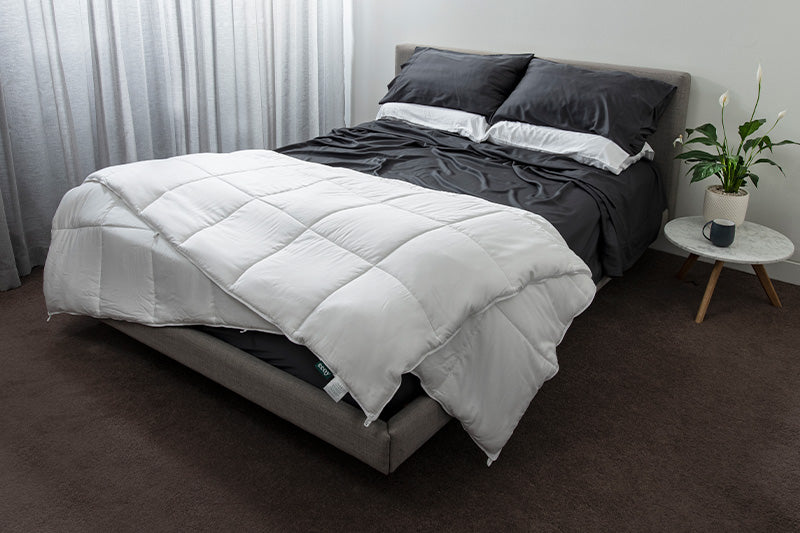What Are Bamboo Quilts Made From? Product Breakdown of a Bamboo Quilt

When it comes to fusing beauty with functionality in the bedroom, bamboo quilts are without a doubt some of the most sought-after items.
By now, you’ve most likely seen wellness online gurus or influencers decorating every corner of their houses with these cult favourites, as they use them as blankets, table runners, wall hangings, and everything in between.
Let us guess, this made you wonder - what are bamboo quilts made from?
In short - bamboo viscose and a certain wadding, which can be polyester, wool, or even a different type of bamboo viscose. Want to know more? Dive into our article where you’ll discover the features and materials that make up bamboo quilts.
What Exactly Are Bamboo Quilts?
Bamboo quilts are bed coverlets made up of two layers of bamboo fibre cloth filled with another layer of wadding.
Their name derives from quilting, a sewing technique that’s been handed down from age to age, enabling people to stitch three layers of fabric together either manually or with a sewing machine.
Their top layer is usually ornamental, adding to the decorative value of your house.
Functionality and comfort-wise, bamboo quilts serve as a lightweight alternative to those heavy-weighted blankets
As we’ll learn everything about their benefits in just a bit, let’s first see what bamboo quilts are made from.
What Are Bamboo Quilts Made From?
The material used in bamboo quilts is usually some sort of filling such as wool, down, polyester, or bamboo viscose wrapped up in a bamboo fibre cover. For instance, our very own bamboo quilts are made of:
- 100% bamboo natural fibre cover;
- Bamboo viscose fill.
This makes them 100% bamboo quilts!
The Cover
The most refined bamboo quilt covers are made of 100% organic bamboo fibre.
What you should understand is that this doesn't mean that the cover is made of 100% pure bamboo material, but that it’s made from bamboo viscose that isn’t mixed with other materials, such as wool or cotton.
For those of you that haven’t read our article on what bamboo pillows are made of, viscose is the process of turning bamboo into textile materials, hence the name of the fabric is bamboo viscose.
What Are the Characteristics of Bamboo Viscose?
To gain a better idea of the characteristics of a bamboo quilt, you need to understand what properties describe the bamboo viscose fabric:
- Bamboo viscose fabric wicks away moisture, which means that it allows sweat, oils, and other bodily fluids to evaporate in the air rather than get soaked up by the material.
- Since it’s resistant to moisture, bamboo viscose fabric has excellent stability. This means that it can retain its shape quite well and for a long period of time.
- Most bamboo viscose fabrics are machine washable, but make sure to check your quilt’s instructions before throwing it in the machine. Once you are sure that you can put your quilt into the washing machine, use a gentle cycle with a mild detergent and lukewarm or warm water.
The Filling
The bamboo quilts’ filling generally depends on the manufacturers.
High-end quilts, however, are stuffed with bamboo viscose whereas others, lower-end products are made from certain thermoplastic fills such as polyester.
Bamboo Fibres vs Polyester
Unlike bamboo, polyester is an artificial fiber, made up of monotheluene glycol (MEG) and purified terephthalic acid.
This sounds extremely scientific, but basically, polyester is a thermoplastic that gets dissolved and then pressed into semi-crystalline fibers through a spinneret during manufacturing.
The next step requires these fibers to undergo a chemical reaction, after which they are ready to be woven together to create polyester fabric.
Why Is Bamboo Superior?
It’s more breathable, softer, and presents an extraordinary opportunity to make eco-friendly, sustainable fabrics in the near future. Polyester, on the other hand, is considered as a more durable fabric, but when taken proper care - bamboo quilts can last for quite some time.
Bamboo, Wool, Cotton, Or Microfibre Quilts: Which One Is Best?
Decorative, functional, or eco-friendly - all quilts can have a special place in your home. But it's not that easy to decide on your next quilt as there are so many materials to choose from. Let’s weigh their pros and cons.
- Bamboo quilts have a natural ability to regulate body temperature, making them excellent both for the winter and the summer months. What makes these quilts stand out is their antimicrobial properties, which may help users reduce allergy flare-ups caused by dust mites found in their bedding. Plus, bamboo is eco-friendly and sustainable!
- Microfibre quilts are made of synthetic material, so they are a cheaper alternative to other fabrics. However, as microfiber absorbs more dirt, sweat, and oils than bamboo, you’ll have to wash this type of quilt more regularly.
- Wool quilts, on the other hand, tend to feel heavier than microfibre quilts, which makes them better for colder months. However, they are also quite a healthy option.
- Cotton quilts are lightweight, comfortable, and wick away moisture, which makes them a great choice for the warm months. The one downside is that cotton is not as environmentally-friendly as bamboo material, as it requires a lot of water and fertilizers to grow.
Final Takeaway
There - now you know what most popular quilts are made of, not just bamboo quilts! Hopefully, having this new knowledge at your disposal will make it easier for you to make a choice on your next aesthetically pleasing - and super comfy - purchase.
If you ask us, regardless of whether you are looking for a decorative, breathable, luxuriously soft, or warm quilt, you can’t go wrong with bamboo!
Sources
- https://www.britannica.com/art/quilting
- https://extension.missouri.edu/publications/g4256
- https://farmandanimals.com/how-much-water-does-it-take-to-grow-cotton/
- https://www.bionity.com/en/encyclopedia/Viscose.html
- https://link.springer.com/chapter/10.1007/978-981-15-8489-3_11
- https://sewingiscool.com/polyester-vs-viscose-difference/
- https://ojs.cnr.ncsu.edu/index.php/JTATM/article/view/651
- https://www.britannica.com/science/polyester
